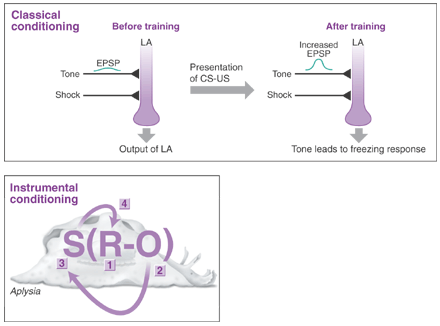
[Return to Article]

Classical and instrumental conditioning. (Top)
One form of classical conditioning involves conditioning animals
to fear a stimulus (7). In the example shown, animals are conditioned
to expect an electric shock (unconditioned stimulus, US) when they
hear an auditory tone (conditioned stimulus, CS). The neurons involved
in learning this connection are situated in the lateral amygdala
(LA), which instigates a conditioned freezing response when the
tone is heard. The cellular mechanism underlying this learned behavior
is a change in the activity of NMDA receptors at specific synapses
(long-term potentiation) that then increase AMPA-type glutamate
receptor currents in lateral amygdala neurons. (Bottom)
Instrumental conditioning in the sea slug Aplysia (4).
During instrumental conditioning, a stimulus (S) results in a response
(R) that leads to an expected outcome (O), usually a reward. (1)
The sea slug exhibits spontaneous biting behavior. (2) Stimulation
of the esophageal nerve responsible for ingestion leads to dopamine
release onto the B51 sensory neuron. (3) If dopamine is applied
to B51 contingent on esophageal nerve activity and biting behavior,
there is a change in the resting potential and excitability of B51.
(4) This change increases the probability that a biting response
will occur.
[Return to Article]
Volume 296, Number 5573, Issue of 31 May 2002, p. 1624.
Copyright
© 2002 by The American Association for the Advancement of Science.
All rights reserved.
|